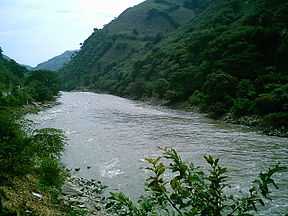Cauca River
| Cauca River | |
|---|---|
 Cauca River in Antioquia | |
 | |
| Origin | Colombian Massif |
| Mouth | Magdalena River |
| Location |
|
| Length | 965 km (600 mi) |
The Cauca River is a river in Colombia that lies between the Occidental and Central cordilleras. From its headwaters in southwestern Colombia near the city of Popayán, it joins the Magdalena River near Magangué in Bolívar Department, and the combined river eventually flows out into the Caribbean Sea. It has a length of 965 km (600 mi) to its junction with the Magdalena, for a total length of 1,350 km (840 mi). from origin to seamouth. The river is under the supervision of the Corporación Regional del Cauca and the Corporación Autonoma Regional del Valle del Cauca, and is navigable for 640 km (400 mi) above its junction with the Magdalena.
Environmental issues
On November 18, 2007, Colombian newspaper El Tiempo reported that the river was receiving an average of 500 tons of residual waste a day. Pollution from the city of Popayán, seven gold mines that also add industrial pollutants such as mercury, some 8 sand mills, plus a couple of mines of coal and bauxite. Cali, the largest city on the river, depends on the river in a 76 percent. Adding to these other affluent rivers collect residual waters from other major cities and deposit an approximate of 330 tons of residual waste into the river. By the time it gets to Yumbo the river has no oxygen.[1]
Social cleansing
In his book End of Millennium, Manuel Castells states the Cali Cartel had participated in social cleansing of hundreds to thousands of "desechables" (English: discardables). The desechables included prostitutes, street children, petty thieves, homosexuals and the homeless. Along with some of the locals, the Cali Cartel formed parties self named grupos de limpieza social (English: social cleansing groups) who murdered the "desechables," often leaving them with signs on them stating: "Cali limpia, Cali linda" (English: clean Cali, beautiful Cali). The bodies of those murdered were often tossed into the Cauca River, which later became known as the River of Death. The municipality of Marsella in Risaralda eventually went broke at the cost of recovering corpses and conducting autopsies.[2][3]
References
- ↑ (Spanish) eltiempo.com: Al río Cauca lo están matando las 500 toneladas de contaminantes que le caen cada día
- ↑ Enid Mumford (1999). Dangerous Decisions: Problem Solving in Tomorrow's World. Springer. pp. 81, 83, 84, 85.
- ↑ Manuel Castells (2000). End of Millennium. Blackwell Publishing. p. 204.
External links
- (Spanish) Corporación Regional del Cauca
- (Spanish) Corporación Autonoma Regional del Valle del Cauca
- '32FA8842805D3774E0440003BA962ED3'&Diacritics=DC Río Cauca at GEOnet Names Server